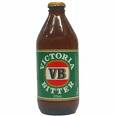 Well, I guess we are going to brew more beer. Didn’t wake up dead and, more importantly, the beer didn’t kill us. With a brisk fist pump and a satisfied smirk the first tasting of the very first batch of Beer Bloke Lager - well, Thomas Coopers in a tin to be completely truthful - can be called a success. Not that we were ever worried. At all. Ever.
Well, I guess we are going to brew more beer. Didn’t wake up dead and, more importantly, the beer didn’t kill us. With a brisk fist pump and a satisfied smirk the first tasting of the very first batch of Beer Bloke Lager - well, Thomas Coopers in a tin to be completely truthful - can be called a success. Not that we were ever worried. At all. Ever.Let me walk you through the full five-sensory experience. With a frisky “TSTT” the cap gave way to release a golden amber - not as light as some lagers, but golden just the same - a nice light cloud to it and a clean aroma. The first thing I didn’t want to cop was any skunk or cabbage. As you would. Nice, hop whiff but not too floral. A little on the soft side. Very easy drinking. Nice malt sweetness - as you’d expect from a full malt brew, even if it was accidental - and certainly, as a result, more full bodied than some lagers. Finished on the tongue a little quickly - though this is not a fault, as such - and left with a delicious little lick of tinny bitterness - a nice, blokey, wet rust kind of tinny.
For its age - remember it is only JUST beer at the two week mark - a ripper beginner. In fact, we were stoked. Stoked blokes. Couldn’t smack the grins off our faces. Happy as a dog with two bones. For, while we expected the first brewing to go off reasonably smoothly, we were really only hoping that it would be more than drinkable. For it to actually taste REALLY GOOD was the froth on top. The froth on top, by the way, was nice and thick in the pouring, but nicked off a bit too soon. The next lager we brew will be a hop-added affair to ensure better head retention.

Cheers
Prof. Pilsner & Dr Lager








 Well, the TWO BREW is bottled and the race to empty the full ones so that we could fill the empty ones was a close thing - won narrowly by the Beer Blokes, tho’ we had to drink as we bottled just to get the last few.
Well, the TWO BREW is bottled and the race to empty the full ones so that we could fill the empty ones was a close thing - won narrowly by the Beer Blokes, tho’ we had to drink as we bottled just to get the last few.













